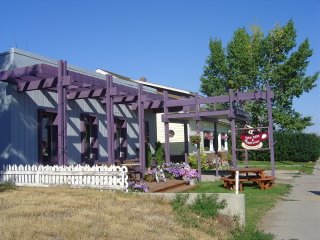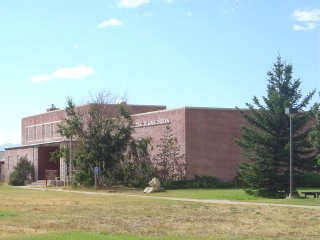Thursday, October 05, 2006
Browning
 West of the Sweet Grass Hills, I pass through Shelby, which 100 years ago was bisected by a railroad called the "Turkey Track." Today it's bisected by I-15. There are two coffee joints, both of them so cute it makes my teeth hurt. I choose the one with internet access. It's called "Cowboy Coffee," and it's painted purple and filled with shelves of potpourri, and no self-respecting cowboy would be caught dead in it.
West of the Sweet Grass Hills, I pass through Shelby, which 100 years ago was bisected by a railroad called the "Turkey Track." Today it's bisected by I-15. There are two coffee joints, both of them so cute it makes my teeth hurt. I choose the one with internet access. It's called "Cowboy Coffee," and it's painted purple and filled with shelves of potpourri, and no self-respecting cowboy would be caught dead in it.On west through Cut Bank, where I find another payphone and call Reggie first and then Rosalyn's mom, to tell her I'm getting close. I'd like to romanticize this part of the trip, but I can find nothing appealing about the towns I'm rolling through today. So it's a relief to come over the rise and see the town of Browning laid out before me.

Browning is the biggest town on the Blackfeet Reservation. Or possibly the Blackfoot Reservation. I've heard both, and the historical interest sign is no help. It's titled "The Blackfeet Nation," and it begins, "The Blackfoot Nation consist of three tribes ...."
 I'd like to romanticize Browning, too, particularly because I have relatives who spend a lot of time here, but it looks as dismal as anything I've heard about Indian reservations. Devoid of shade and water, wind-blown, full of houses that testify to the government's tendency to do things on the cheap whenever they involve actual people (leaving open, for now, the question of whether the government regarded Indians as actual people when it built this place).
I'd like to romanticize Browning, too, particularly because I have relatives who spend a lot of time here, but it looks as dismal as anything I've heard about Indian reservations. Devoid of shade and water, wind-blown, full of houses that testify to the government's tendency to do things on the cheap whenever they involve actual people (leaving open, for now, the question of whether the government regarded Indians as actual people when it built this place).Dogs range up and down the streets. There's a main drag that has a few gas stations, an IGA, a big A-frame building with "Trading Post" painted on the roof in 20-foot high letters, and a few unappealing restaurants. Oh, and an enormous concrete teepee that houses an espresso bar.
I pull in at a diner housed in a log cabin. It's full of friendly, helpful people who let me use their phone when I explain I'm trying to call my cousin's mom in town. The waitress assures me the cowboy soup, which is made not from cowboys but from hamburger and macaroni, is good, and it is, in a salty, beefy, homey kind of way. There are three firemen on their lunch break proving that firemen are hotties regardless of the location or culture, and an extremely overweight family, and a table of tourists who look even more curious about these Indians than I am, and more intimidated than I've become after spending two or three weeks learning to assume that everyone I encounter is going to be friendly and helpful.
 Angie, Rosalyn's mom, gives me directions to the Cuts Wood School, which is where she says I can find Rosalyn. I walk in and find Rosalyn right there, without warning, and we each give the other a startled hello, as if it's passing strange to see this familiar person here in this place that's on the other side of the middle of nowhere.
Angie, Rosalyn's mom, gives me directions to the Cuts Wood School, which is where she says I can find Rosalyn. I walk in and find Rosalyn right there, without warning, and we each give the other a startled hello, as if it's passing strange to see this familiar person here in this place that's on the other side of the middle of nowhere.Cuts Wood School is a tiny little place, the next thing to a one-room school, where elementary and middle-school children learn in the Blackfoot language. It's bright and cheerful inside, a school that kids might feel good about walking into, and the walls are covered with pictures of everyday things labeled with their Blackfoot names. Everyone half-apologizes and half-complains about the pile of packs and bedrolls left by a group of do-gooder college students from somewhere who have come to Browning to paint houses or some such thing.
We sit and talk for a few minutes, Rosalyn and her colleague Shirlee and I and a one or two other folks who are around here during the summer. I want to ask about something, so I ask about the "Blackfoot/-feet" thing, and based on Shirlee's reaction I can see I've asked an exasperating question, possibly because it's a stupid little thing that nobody can resolve, or possibly because it's the stupid sort of thing that white people ask about when they come to Browning. But even stupid questions can lead to interesting answers, and I find out about the three tribes that make up the Blackfoot Nation and some of their history. (The three tribes are the Siksika, or "Blackfoot," the Kainai, or "Bloods," and the Piegans. It's mostly Piegans who live in Browning and on the Blackfeet reservation in the US; the Cuts Wood School is run by an organization called the Piegan Institute. The Piegans aren't known by the English translation of their name, which seems to have something to do with being poorly clothed.)(As long as we're into this: they mostly say Blackfoot in Canada and Blackfeet in the US. "Blackfeet" seems to have resulted from some bureaucrat's conclusion that if there's more than one member of the nation, the name had to be plural. And now we can let this topic go for a while.)
 Rosalyn has some things to do, so I head off to the Museum of the Plains Indian, which is over at the edge of town near the construction site for the new casino. Rosalyn looks a little sideways at this idea, and I ask her about it, and she explains that it's probably worth doing, it just hasn't changed since she first went there many years ago. She tells me not to miss the movie narrated by Vincent Price.
Rosalyn has some things to do, so I head off to the Museum of the Plains Indian, which is over at the edge of town near the construction site for the new casino. Rosalyn looks a little sideways at this idea, and I ask her about it, and she explains that it's probably worth doing, it just hasn't changed since she first went there many years ago. She tells me not to miss the movie narrated by Vincent Price.It's not a bad museum, but it's pretty stale compared to the whiz-bang stuff you get today. Vincent Price movie, there is none; the woman at the front desk tells me it broke several years ago. She doesn't seem disappointed that it broke. She offers to recreate it for me word-for-word, but I pass.
The displays have a lot of clothing in them, and other crafts, and I realize that just about every Hollywood stereotype of an Indian that you've ever seen comes from Plains Indians - teepees, feather headdresses, buckskin pants (which aren't pants but actually just pant legs, assembled with a loin cloth). Some toys and games are displayed as well - one of them is a hoop that the young men would try to throw a spear through, and based on the size of the hoop, it was either an endlessly frustrating game or they were pretty good with spears.